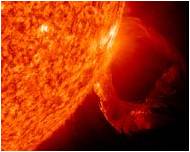By Pennell Paugh
Though the Earth is constantly bombarded by charged particles from the Sun, which emits material in all directions in a process known as the solar wind, sometimes the Sun ramps up magnetic activity on its surface, triggering huge flares of insidious plasma.
NASA Science News announced that a huge solar storm occurred between March 8 and 10. “This was the biggest dose of heat we’ve received from a solar storm since 2005,” says Martin Mlynczak of NASA Langley Research Center. The skies at both poles were filled with dramatic aurora displays, also known as the northern and southern lights.
Measured by the SABER sensor onboard the TIMED satellite run by NASA, the sun storm flooded the Earth’s thermosphere, dumping enough energy on Earth to power New York City for two years. Earth’s gravitational field protected us from most of the storm. The thermosphere re-reradiated 95% of the energy from the storm back into space.

Aurora Borealis (Australis), or the Northern (Southern) Lights, are a visible byproduct of the Earth's magnetosphere repelling energy from the Sun. Image reproduced from CCJ.
While the Earth’s magnetosphere can repel most of the energy from sun storms, there are mounting concerns regarding the Earth’s electrical grid. If they’re powerful enough, geomagnetic storms can temporarily disrupt GPS satellites, radio communications and power grids.
The danger is becoming more critical, as the Sun is approaching what’s known as solar maximum—the high point in our star’s roughly 11-year cycle of activity. Scientists anticipate stronger storms around solar maximum in 2013.
The sprawling electrical grid on Earth’s surface acts like an antenna, allowing currents from the storms to flow into transmission lines. The largest electric currents are funneled toward Earth around the Poles. An example of a power grid being taken down by sun storms includes the transmission system for Canada’s Hydro Quebec in 1989, which left millions of people without power for more than nine hours.
Canadian utilities, being located closer to the magnetic North Pole, actively monitor geomagnetically-induced currents, model impacts for vulnerability, and refine their operational protocols. European utilities and the South African electricity provider, ESKOM, are also preparing for the upcoming solar maximum, in part with advice and data from NASA.
References
Phillips, T. (March 22, 2012) “Solar Storm Dumps Gigawatts into Earth’s Upper Atmosphere,” NASA Science News, Retrieved from: http://science.nasa.gov/science-news/science-at-nasa/2012/22mar_saber/
Jaggard, V. (August 3, 2011) “As Sun Storms Ramp Up, Electric Grid Braces for Impact,” National Geographic Daily News. Retrieved from: http://news.nationalgeographic.com/news/energy/2011/08/110803-solar-flare-storm-electricity-grid-risk/
Wall, M. (December 29, 2011) “Sun Storms May Slam Earth on Wednesday,” Fox News. Retrieved from: http://www.foxnews.com/scitech/2011/12/28/sun-storms-may-super-charge-northern-lights-wednesday/


Comments are closed.